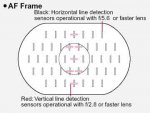Tony Field
New member
One of the interesting things I recently found out is that my 1D-IIn and 5D cannot be perfectly calibrated to all of my 10 lenses. The service tech here in Calgary indicated that it is possible to almost perfectly calibrate (within human ability) all lenses to a single camera however it is "impossible" (except by manufacturing accident) to perfectly do that with multiple bodies.
Here is the resulting situation. My 1D-IIn virtually perfectly focuses my 24 1.4, 35 1.4,50 1.4, 85 1.2, 100 F2, 135 F2, 300 F2.8, and zoom lenses - the point if maximum sharpness is where it should be - 1/3 to 1/2 into the depth of field region.
The 5D, on the other hand consistently focuses in the back 2/3's of the DOF for all lenses.
The Canon service tech (who is VERY competent, IMHO) says he cannot do better than that- it is part of the design constraints of the cameras. Since the consistency of focus is very fine indeed for each camera, he obviously has the skill to do the very best possible.
The minor down-side of this is that the 1D-IIn becomes the camera of choice for large-aperture shots with limited DOF. On the other hand, since the focus consistency of the 5D is so well done for all the lenses, I guess it is reasonable to "learn" to focus on alternate spots of the subject to allow sharp wide-open shots.
It would be interesting to know if this is really the case Is it possible for perfect calibration for many lenses, many bodies?
Is it possible for perfect calibration for many lenses, many bodies?
tony
Here is the resulting situation. My 1D-IIn virtually perfectly focuses my 24 1.4, 35 1.4,50 1.4, 85 1.2, 100 F2, 135 F2, 300 F2.8, and zoom lenses - the point if maximum sharpness is where it should be - 1/3 to 1/2 into the depth of field region.
The 5D, on the other hand consistently focuses in the back 2/3's of the DOF for all lenses.
The Canon service tech (who is VERY competent, IMHO) says he cannot do better than that- it is part of the design constraints of the cameras. Since the consistency of focus is very fine indeed for each camera, he obviously has the skill to do the very best possible.
The minor down-side of this is that the 1D-IIn becomes the camera of choice for large-aperture shots with limited DOF. On the other hand, since the focus consistency of the 5D is so well done for all the lenses, I guess it is reasonable to "learn" to focus on alternate spots of the subject to allow sharp wide-open shots.
It would be interesting to know if this is really the case
tony
Last edited:

